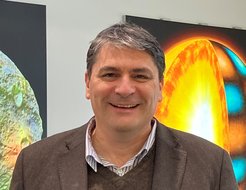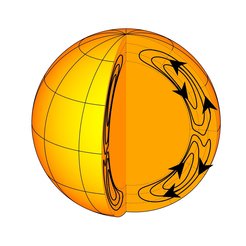Biermann Lectures 2020: Dynamics of the Solar Interior
By Prof. Laurent Gizon, Director at the MPI for Solar System Research, Göttingen
One might think that there is little more to learn about our home star, the Sun. But it has guarded its secrets well. The origin of its 22-year magnetic cycle remains hidden deep in its interior. In this year’s Biermann lectures, Prof. Laurent Gizon from the MPI for Solar System Research will discuss the motions in the solar interior, which drive the solar dynamo.

The department "Solar and Stellar Interiors" was created at the Max Planck Institute for Solar System Research in April 2011 with Prof. Laurent Gizon as director, as a joint initiative of the Max Planck Society, the University of Göttingen, and the state of Niedersachsen. The department’s main focus is to understand how the Sun and stars work by looking into their interiors using acoustic oscillations as probes. For the Sun, the space observatories SDO and SOHO, as well as the ground-based network GONG provide the necessary data. An important upcoming mission for the department is Solar Orbiter, launched in February 2020, which will study the dynamics of the polar regions of the Sun for the first time.
After studying astrophysics in Toulouse, Laurent Gizon obtained his Ph.D. in physics at Stanford University in 2003. He was a Max Planck Research Group leader at the Max Planck Institute for Solar System Research from 2005 to 2011, where he developed techniques of local helioseismology to map the interior of the Sun in three dimensions. In 2011 he was jointly appointed a full professor at the University of Göttingen and a Scientific Member and Director at the Max Planck Institute for Solar System Research.

In this year’s Biermann lectures, he will first explain how to use seismic waves to learn about the solar interior, in particular how to infer plasma flows in the solar convection zone. The inferred flows include the differential rotation, which winds up the magnetic field that later emerges as sunspots. The inferred meridional flow, discussed in the second lecture, transports the magnetic field in the latitudinal direction, and thereby sets the period of the Sun’s 22-year magnetic cycle.
In the context of other stars, we need to understand the physical processes that lead to differential rotation and meridional circulation. An important step is to understand the interaction between convection and rotation at large spatial scales. Observational clues and constraints include newly-discovered low-frequency modes of oscillation, with periods on the order of the rotation period of the Sun. These modes will be discussed in the third lecture.
Overall title:
Dynamics of the Solar Interior
Tuesday, 1.12. 15:00
Seismic Diagnostics of the Solar Interior
Tuesday, 8.12. 15:00
In Pursuit of the Deep Solar Meridional Flow
Tuesday, 15.12. 15:00
Low-frequency Oscillations of the Rotating Sun
Due to the COVID situation, the Biermann lectures 2020 will take place in hybrid form, with only limited spaces available at MPA. If you are interested in joining online, please contact Maria Depner maria@MPA-Garching.MPG.DE

